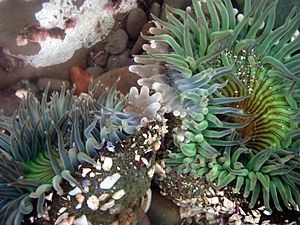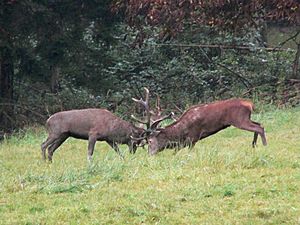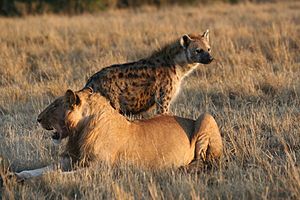Competition (biology) facts for kids


In biology, competition happens when living things need the same limited resources. These resources can be things like food, water, space, or even sunlight. When there isn't enough for everyone, individuals or groups have to compete to get what they need to survive and grow.
Competition can happen in two main ways:
- Intraspecific competition is when individuals from the same species compete. For example, two male deer might fight over a female or territory.
- Interspecific competition is when individuals from different species compete. For instance, lions and hyenas might compete for the same prey.
This struggle for resources is very important in evolution. It helps decide which individuals or species are best suited to their environment. Those that compete well are more likely to survive, reproduce, and pass on their traits. This process is a key part of natural selection.
Contents
How Competition Happens
Competition can occur in different ways, either directly or indirectly.
Direct Competition (Interference)
Interference competition happens when individuals directly stop others from getting resources. They might use aggression or physical force.
- Imagine two sea anemones fighting for space on a rock. They might sting each other to claim their spot.
- Animals can also interfere by chasing others away from food or nesting sites.
Indirect Competition (Exploitation)
Exploitation competition happens indirectly. It's not about fighting, but about who uses the resources first.
- If one animal eats all the berries in an area, there are no berries left for another animal. The first animal "exploited" the resource, leaving nothing for the second.
- Trees in a forest compete for sunlight and water in the soil. Taller trees might block sunlight from smaller ones, and trees with wider root systems might absorb more water.
Hidden Competition (Apparent)
Apparent competition is also indirect and a bit tricky. It happens when two different species seem to compete, but they are actually both affected by the same predator.
- For example, if a hawk eats both mice and rabbits, an increase in the number of mice might lead to more hawks. More hawks then means fewer rabbits, even though mice and rabbits don't directly compete for food. They are linked through their shared predator.
Related topics

Images for kids
-
Great egret and neotropic cormorant competing over territory
-
Medium ground finch (Geospiza fortis) on Santa Cruz Island in the Galapagos
See also
 In Spanish: Competencia (biología) para niños
In Spanish: Competencia (biología) para niños



